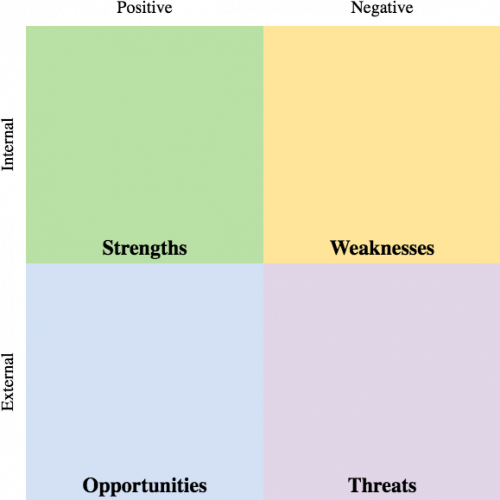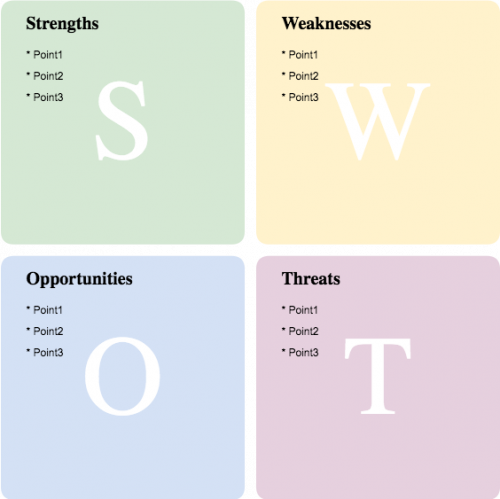Using a SWOT analysis to develop core business strategies
Brandi Gratis
December 13, 2021
A SWOT Analysis is an integral part of any good business plan. Whether you’ve been in business for ten years or you’re just getting specifics together for a new product, a thoughtful SWOT analysis will inform every part of your business.
SWOT is an acronym that stands for Strengths, Weaknesses, Opportunities, and Threats. You can use a simple list to conduct your analysis, but it’s most commonly formatted using a SWOT diagram.

The basics of a SWOT Analysis
When coming up with your list of strengths and weaknesses, think about internal factors like patents, expertise, staff, funding, location, etc.
When thinking about your list of opportunities and threats, think about external factors like suppliers, competitors, prices, the market, etc.
Strengths and weaknesses are things you can control and change with varying degrees of effort.
Opportunities and threats are things that exist in the world or market regardless of what your business does. You most likely can’t change these things.
When should you conduct a SWOT Analysis?
Existing businesses
Existing businesses will want to do a SWOT Analysis under these circumstances:
- In response to a changing environment, so they can assess and respond proactively
- At regularly scheduled strategy meetings
- At the beginning of major projects
New businesses
New businesses will use the SWOT Analysis to help formulate their business plan. It’s an initial step towards creating a cohesive strategy that will be unique to their business.
How to conduct a SWOT Analysis
The more perspectives you can get involved in your SWOT Analysis, the better. Include people across your company to help you understand the particular strengths, weaknesses, opportunities, and threats that face every department at every level.
This exercise is also an opportunity for different departments to connect and align with the grander vision of the company. Participation encourages adherence to the resulting strategy and makes every part of the company feel included in and integral to driving the business forward.
A SWOT Analysis diagram is simple to create (and we offer multiple templates for it in Cacoo). It’s made up of four squares, laid out two by two, each labeled as one of the four sections.

You can ask your team to prepare ideas before coming to your meeting, but active and collaborative brainstorming should be encouraged. As different perspectives bring new ideas to light, you’ll begin to identify the most important and unifying elements.
You don’t need to elaborate on any one point too much within the SWOT diagram. Bulleted points for each item will suffice. Plus, it makes organizing much easier, which is the next step.
Once you’re finished brainstorming, it’s time to prioritize your items with the highest priority listed at the top of each section in descending order. Remove items that won’t have a significant impact on the business. In the end, you should have a finalized version of your SWOT Analysis.
Questions to guide your SWOT Analysis
If you’re not sure where to start, here are a few questions to help guide the conversation. This is by no means an exhaustive list of things that can or should be discussed during this exercise.
Strengths (internal, positive factors)
When listing your company’s strengths, you want to think about internal, positive factors within your control.
- What does your business do well?
- Do you have any advantages over your competition?
- What types of resources does your business have?
- What assets does the company have?
- How can you utilize the expertise of your staff?
Weaknesses (internal, negative factors)
When listing your company’s weaknesses, think about internal, negative factors that detract from your business’s ability to reach its greatest potential.
- Which areas of your business need the most improvement?
- What kinds of resources does your business lack?
- What expertise does your business lack?
- Which assets does your company lack?
- What disadvantages does your business face compared with your competition?
Opportunities (external, positive factors)
When listing your company’s opportunities, you want to think about external, positive factors that could aid your business.
- Does the current state of the market offer any unique benefits?
- Are there any recent changes in the market that have created new opportunities?
- How could you acquire more resources, expertise, or assets?
- How important is timing to any of the opportunities you identified?
Threats (external, negative factors)
When listing your company’s threats, you want to think about external factors beyond your control that could put your business or strategy at risk.
- What about the current state of the market could hurt your business?
- Are there any recent changes in the market that have diminished previous opportunities?
- What strategies are your current and potential competitors using?
- Are there threats to your existing resources, expertise, or assets?
- How important is it to react to these threats immediately?
Developing strategies from your analysis
Once you’ve completed your SWOT results, it’s time to use those insights to develop strategies for your business. However, a basic SWOT diagram presents each factor equally and doesn’t weigh their overall importance in your business plan. To get the most out of your analysis, you need to go a step further.
Both the good and bad points that come up in your analysis will have different levels of impact on your business. By considering how different factors overlap, you can decide what to prioritize to help your business grow. This additional layer of prioritization is known as a TOWS Analysis or TOWS Matrix.
To do this, look at how your diagram sections overlap in the following ways:
- Strength-Opportunity Strategies: Can you use any of your strengths to maximize your opportunities?
- Strength-Threats Strategies: Can you use any of your strengths to minimize your threats?
- Weakness-Opportunity Strategies: Can you leverage opportunities to minimize your weaknesses?
- Weakness-Threats Strategies: Can you address your biggest weaknesses to minimize threats?
The limitations of SWOT Analysis (and how to overcome them)
The best thing about a SWOT analysis is that anyone can do it — even a complete novice. However, it’s only meant to be a starting point in the planning process, and it may not reflect the complexity of your business situation. So, let’s talk a little about the limitations you could encounter and how to manage them.
Business challenges are multilayered
Many elements of your business fall into multiple categories on the SWOT diagram. For example, some of your company’s greatest strengths could also be weaknesses. Let’s say you have a great core customer base and have devoted a lot of time to fostering strong relationships with them. Of course, this is a strength.
At the same time, you may become so focused on serving their niche needs that you struggle to attract other types of customers. Lack of diversification is a major flaw that will prevent your company from growing. Yet, this may not appear to be a pressing problem on your initial diagram and won’t be prioritized accordingly.
Your information sources may be biased
Try not to rely solely on self-reported data in your analysis. Weaknesses and threats, in particular, may stem from a different source than you expected. And if you conduct a SWOT analysis with incorrect information, you’ll be no closer to solving your problems. Ensure you have reliable evidence for any factor you include in the analysis. Otherwise, the whole process will be guesswork.
Opportunities and threats are often conditional
Leveraging your resources the right way isn’t a simple matter because business conditions tend to fluctuate or have varying stakes. For instance, many of the opportunities on your list may require a financial investment that would put undue strain on your business. You could only capture those extra profits by taking a huge risk or waiting for better circumstances.
Threats and opportunities can also be time-sensitive. A SWOT analysis doesn’t take conditional factors into account. As a result, a problem you identified as low-stakes in your assessment could significantly escalate while you’re focused on seizing opportunities.
Gather various sources of information for your SWOT Analysis
Limitations aside, a SWOT analysis is still useful for planning your next steps. The important thing is to foster accuracy during every step of the process. Your team has valuable insight, but employee opinions are only one part of the puzzle. They can only share what they have personally experienced, but as a business owner, you need to see the whole picture.
Here are some best practices to keep in mind:
- Develop scenarios for each set of priorities. As you perform the SWOT/TOWS diagram, think about conditional factors that could significantly affect a strength, weakness, opportunity, or threat. This should be based on trends in your industry or conditions that already exist in your business. Factors that are highly prone to fluctuations should be monitored more closely, in case they change from low to high stakes very quickly.
- Back up assumptions with data. Ask your team to come prepared with specific examples or data at your strategy sessions. Not only will this allow you to measure improvement, but it helps you to gain an accurate picture of what you’re doing right and what you need to do to improve.
- Do further research. Delve deeper into the objectives in your SWOT analysis. For example, you may need market research to figure out how to differentiate your business or financial advice to understand which opportunities are best for the company.
Final thoughts
As internal and external factors change, your strategies will need to adapt to them. It’s essential to conduct a regularly scheduled SWOT Analysis of your business to make sure you’re pivoting your strategy regularly and accurately.
Searching for the right diagramming tool?
Check out Cacoo, a diagramming tool for better team collaboration.
This post was originally published on June 6, 2017, and updated most recently on December 13, 2021.


